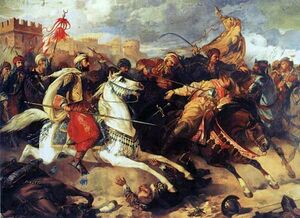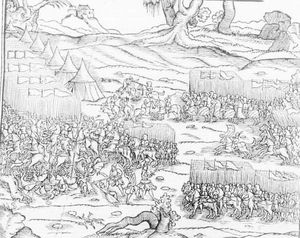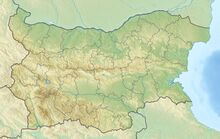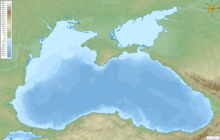معركة ڤارنا
| معركة ڤارنا Battle of Varna | |||||||
|---|---|---|---|---|---|---|---|
| جزء من الحروب العثمانية في اوروبا | |||||||
 The Crusaders were trapped below. Their defeat permitted the Fall of Constantinople. Beyond the Ottoman Sultan and the Janissaries was the cradle of medieval Bulgaria. | |||||||
| |||||||
| المتحاربون | |||||||
|
| |||||||
| القادة والزعماء | |||||||
|
| |||||||
| القوى | |||||||
| ~ 20,000-30,000 | ~ 60,000[2][3] | ||||||
| الضحايا والخسائر | |||||||
| ~ 11,000 | ~ 8,000 | ||||||
الموقع داخل بلغاريا | |||||||
دارت رحى هذه المعركة بين الجيش العثمانى بقيادة السلطان مراد الثاني وجيش أوربى شاركت فيه المجر وقولونية وألمانيا وفرنسا والبندقية وبيزنطة وبيرجوذريا بقيادة الملك المجري "يانوش هونيادى" واختير الملك البولندى "ڤلاديسلاڤ الثالث" قائدًا شرفيًا للحملة. وقعت هذه المعركة في (28 رجب 848هـ/ 10 نوفمبر 1444) في مدينة "فارنا" البلغارية على شاطئ البحر الأسود.
شعر السلطان مراد الثاني بالتعب فقرر التخلى عن العرش لابنه محمد الثاني الذى عرف فيما بعد بالفاتح، وكان عمره آنذاك (12) سنة فطمع الأروبيون في الدولة العثمانية وشكلوا جيشًا كبيرًا من قوات عدة دول أوربية ليهاجم الدولة العثمانية. وإزاء هذه التطورات اجتمع مجلس شورى السلطنة العثمانية وطلب عودة السلطان مراد الثانى فعاد وأعد جيشه للقاء تلك الحملة الصليبية والتقى بهذه الحملة في مدينة "فارنا" على شاطىء البحر الأسود، فانتصر الجيش المسلم انتصارًا ساحقـًا في هذه المعركة وقتل الملك البولندى "ڤلاديسلاڤ الثالث" وهرب القائد العام المجري "هونيادى" من المعركة وبهذا النصر أيقن الأروبيون صعوبة طرد العثمانين من منطقة البلقان.
خلفية
The Hungarian Kingdom fell into crisis after the death of King Sigismund in 1437. His son-in-law and successor, King Albert, ruled for only two years and died in 1439, leaving his widow Elizabeth with an unborn child, Ladislaus the Posthumous. The Hungarian noblemen then called the young King Władysław III of Poland to the throne of Hungary, expecting his aid in defense against the Ottomans. After his Hungarian coronation, he never went back to his homeland again, assuming rule of the Hungarian Kingdom next to the influential nobleman John Hunyadi.
After failed expeditions in 1440–1442 against Belgrade and Transylvania and the defeats of the Turks during Hunyadi's "long campaign" in 1442–1443, the Ottoman sultan Murad II signed a ten-year truce with Hungary. After he had made peace with the Karaman Emirate in Anatolia in August 1444, he resigned the throne to his twelve-year-old son Mehmed II.
Cesarini insisted that the Hungarian King Władysław III should break the treaty, arguing that it was not valid due to the fact that it had been made with infidels.[4] Hungary co-operated with Venice and Pope Eugene IV to organize a new crusader army led by Hunyadi and Władysław III. On receipt of this news, Çandarlı Halil Pasha recalled Murad II against the Christian Coalition, even though Mehmed II did not accept this and wanted to fight himself.[بحاجة لمصدر] As a result, Murad II commanded the Ottoman army.
التحضير
The mixed Papal army was composed mainly of Hungarian, Polish, Bohemian (whose combined armies numbered 16,000) and Wallachian (4,000) forces,[5] with smaller detachments of papal troops, Teutonic Knights, Czechs, Bosnians, Croats, Bulgarians, Lithuanians, and Ruthenians.[6] Troops from Croatia and Bosnia were led by Croatian nobleman Franko Talovac.[7]
Papal, Venetian and Burgundian ships under Alvise Loredan had blockaded the Dardanelles as the Hungarian army was to advance on Varna, while a second flotilla comprising six ships (two Burgundian, two Ragusan and two Byzantine) blockaded the Bosphorus. Both failed, and the main Ottoman force from Asia, including the sultan, crossed the Bosphorus on 18 October 1444.[8] The Hungarian advance was rapid, Ottoman fortresses were bypassed, while local Bulgarians from Vidin, Oryahovo, and Nicopolis joined the army (Fruzhin, son of Ivan Shishman, also participated in the campaign with his own guard). On October 10 near Nicopolis, some 7,000[8] Wallachian cavalrymen under Mircea II, one of Vlad Dracul's sons, also joined.
Armenian refugees in the Kingdom of Hungary also took part in the wars of their new country against the Ottomans as early as the battle of Varna in 1444, when some Armenians were seen amongst the Christian forces.[9]
نشر القوات

Late on November 9, a large Ottoman army of around 60,000 men approached Varna from the west. At a supreme military council called by Hunyadi during the night, the papal legate, cardinal Julian Cesarini, insisted on a quick withdrawal. However, the Christians were caught between the Black Sea, Lake Varna, the steep wooded slopes of the Franga Plateau (356 m high), and the enemy. Cesarini then proposed a defense using the Wagenburg of the Hussites until the arrival of the Christian fleet. The Hungarian magnates and the Croatian and Czech commanders backed him, but the young (20-year-old) Władysław and Hunyadi rejected the defensive tactics. Hunyadi declared: "To escape is impossible, to surrender is unthinkable. Let us fight with bravery and honor our arms." Władysław accepted this position and gave him the command. Andreas del Palatio states that Hunyadi commanded the "Wallachian army" indicating a large Romanian component in Hunyadi's personal army.[10]
In the morning of November 10, Hunyadi deployed the army of some 20,000 crusaders as an arc between Lake Varna and the Franga plateau; the line was about 3.5 km long. Two banners with a total of 3,500 men from the king's Polish and Hungarian bodyguards, Hungarian royal mercenaries, and banners of Hungarian nobles held the center. The Wallachian cavalry was left in reserve behind the center.
The right flank that lined up the hill towards the village of Kamenar numbered 6,500 men in 5 banners. Dalmatian John de Dominis, Bishop of Varadin with his personal banner led the force; Cesarini commanded a banner of German mercenaries and a Bosnian one. The Bishop of Eger Simon Rozgonyi led his own banner, and the military governor of Slavonia, ban Franko Talovac, commanded one Croatian banner.
The left flank, a total of 5,000 men in 5 banners, was led by Michael Szilágyi, Hunyadi's brother in law, and was made up of Hunyadi's Transylvanians, Bulgarians, German mercenaries and banners of Hungarian magnates. Behind the Hungarians, closer to the Black Sea and the lake, was the Wagenburg, defended by 300 or 600 Czech and Ruthenian mercenaries under hetman Ceyka, along with Poles, Lithuanians and Wallachians. Every wagon was crewed with 7 to 10 soldiers and the Wagenburg was equipped with bombards.
The Ottoman center included the Janissaries and levies from Rumelia deployed around two Thracian burial mounds. Murad observed and directed the battle from one of them. The Janissaries dug in behind ditches and two palisades. The right wing consisted of Kapikulus and Sipahis from Rumelia, and the left wing was made up by Akıncıs, Sipahis from Anatolia, and other forces. Janissary archers and Akıncı light cavalry were deployed on the Franga plateau.
المعركة
The light Ottoman cavalry assaulted the Croats of ban Franco Talotsi.[11] Christians from the left riposted with bombards and firearms and stopped the attack. Christian soldiers chased the Ottomans in a disorderly pursuit. The Anatolian cavalry ambushed them from the flank. The Christian right wing attempted to flee to the small fortress of Galata on the other side of Varna Bay, but most of them were slain in the marshland around Varna Lake and the River Devnya, where Cesarini also met his end. Only ban Talotsi's troops managed to withdraw behind the Wagenburg.

The other Ottoman flank assaulted the Hungarians and Bulgarians of Michael Szilagyi. Their push was stopped and turned back; then Sipahis attacked again. Hunyadi decided to help and advised Władysław to wait until he returned; then advanced with two cavalry companies. The young king, ignoring Hunyadi's advice, rushed 500 of his Polish knights against the Ottoman center. They attempted to overrun the Janissary infantry and take Murad prisoner, and almost succeeded, but in front of Murad's tent Władysław's horse either fell into a trap or was stabbed, and the king was beheaded by mercenary Kodja Hazar.[12] The remaining coalition cavalry were demoralized and defeated by the Ottomans.
On his return, Hunyadi tried frantically to salvage the king's body, but all he could accomplish was to organize the retreat of the remains of his army; it suffered thousands of casualties in the chaos, and was virtually annihilated. Neither the head nor body of the king were ever found. The minnesinger Michael Beheim wrote a song based on the story of Hans Mergest, who spent 16 years in Ottoman captivity after the battle.
الأعقاب

Hunyadi reached the Danube but was captured by Vlad Dracul in Wallachia and imprisoned as insurance in case of Ottoman retaliation or for a high ransom. He was released in exchange for a large amount of money when Hungarian nobles loyal to Hunyadi began to threaten Vlad Dracul with a campaign against him. Another version of the story is that he was mistakenly captured by Wallachian border guards, who didn't recognize him, and released by Vlad Dracul once they met face to face.[4] After the death of Władysław III, Hunyadi became one of the most important and powerful members of the Hungarian nobility, becoming the Governor of Hungary on the 5th of June 1446. He was later made a Duke by the Pope in 1447.[4]
Hungarian nobles found it hard to believe that both their king and Cesarini had died, leading to spies being sent south of the Danube, but no information was found other than what was already known.[4]
The death of Władysław III left Hungary in the hands of the four-year-old Ladislaus Posthumous of Bohemia and Hungary. He was succeeded in Poland by Casimir IV Jagiellon after a three-year interregnum.
Murad's casualties at Varna were so heavy, it was not until three days later that he realized he was victorious.[13] Nevertheless, the Ottoman victory in Varna, followed by the Ottoman victory in the Second Battle of Kosovo in 1448, deterred the European states from sending any substantial military assistance to the Byzantines during the Ottoman siege of Constantinople in 1453. Hunyadi signed a three-year truce with the Ottoman central government in 1451.
Only the European victory at Belgrade would stop the Ottomans from conquering large parts of Europe. Hungary would be safe for another 70 years after this victory until the Hungarian army was crushed by the Ottomans at the Battle of Mohács in 1526, which would lead to the end of Hungary as an independent united kingdom for almost 400 years.[4]
الذكرى
In the aftermath, the Ottomans had removed a significant opposition to their expansion into central and eastern Europe; subsequent battles forced a large number of Europeans to become Ottoman subjects.
The fallen Polish King was named Władysław III Warneńczyk in memory of the battle.
The Battle of Varna is commemorated on the Tomb of the Unknown Soldier, Warsaw, with the inscription "WARNA 10 XI 1444".
انظر أيضاً
المصادر
- ^ İnalcık, Halil. Fatih devri üzerine tetkikler ve vesikalar. p. 107.
- ^ Turnbull, Stephen, The Ottoman Empire: 1326-1699, Osprey Publishing, p. 34 "...Hunyadi had chosen a strong position between the end of a marsh and the bay. Scouts brought news that the Turkish army was scarcely 4,000 paces away and numbered at least 60,000 men..."
- ^ Setton, Kenneth Mayer, The Papacy and the Levant, (1204-1571) Vol.2: The Fifteenth Century, p. 90 "...By this time the Turkish army may have contained 60,000 men (probably Murad himself did not know how many he had) almost outnumbering the Christians by three to one..."
- ^ أ ب ت ث ج Pogãciaş, Andrei (2011). "The Campaign of Varna, 1444: An Example of How to Lose a Victory". Medieval Warfare. 1 (2): 43-48.
- ^ Setton 1978, pp. 89–90.
- ^ Magyarország hadtörténete (1984), pp. 102–103
- ^ Pogăciaș 2015, p. 331.
- ^ أ ب Jefferson, John (2012). The Holy Wars of King Wladislas and Sultan Murad. pp. 437–438. ISBN 978-9004219045.
- ^ Basmadjian, Garabed (1922). Histoire moderne des Armeniens (in الفرنسية). Paris: J. Gamber. p. 45.
- ^ Istoria Romaniei, Vol II, p. 440, 1960
- ^ "PARK-MUSEUM OF THE COMBAT FRIENDSHIP 1444 "WLADISLAW WARNENCHIK"". www.varnenchikmuseum.com. Retrieved 2019-10-26.
- ^ Jaczynowski, Lech (January 2017). Supposed Gravesites of Władysław III of Varna (PDF). p. 193. ISBN 9788374555265. Retrieved 21 December 2017.
- ^ Kenneth Meyer Setton, The Papacy and the Levant, 1204–1571: The Fifteenth Century, Vol. II, (American Philosophical Society, 1978), 90.
وصلات خارجية
- Battle map (بالمجرية)
- Imber, Colin (2006). The Crusade of Varna, 1443-45. Ashgate Publishing. ISBN 0-7546-0144-7.
{{cite book}}: Unknown parameter|month=ignored (help) (متواجد على الوب: مقدمة (PDF))
- CS1 الفرنسية-language sources (fr)
- Short description is different from Wikidata
- مقالات ذات عبارات بحاجة لمصادر
- CS1 errors: unsupported parameter
- عثمانيون
- تاريخ بلغاريا
- 1444
- معارك المجر
- الحرب في العصور الوسطى
- ڤارنا
- معارك الحروب العثمانية المجرية
- حملة ڤارنا الصليبية
- نزاعات 1444
- 1444 في أوروپا
- 1444 في الدولة العثمانية
- القرن 15 في بلغاريا
- معارك بلغاريا
- معارك الدولة العثمانية
- معارك بوهيميا
- معارك پولندا
- معارك گراندوقية لتوانيا
- معارك مولداڤيا
- معارك صربيا
- معارك ولاخيا
- معارك العصور الوسطى
- الحملات الصليبية في القرن 15
- عن إسلام أون لاين.نت




